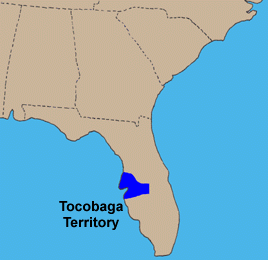
Tocobaga
Tocobaga (also Tocopaca) was the name of a chiefdom, its chief and its principal town during the 16th century in the area of Tampa Bay. The people of Tocobaga were in the Safety Harbor culture area. The town was at the northern end of what is now called Old Tampa Bay, an arm of Tampa Bay that extends northward between the present-day city of Tampa and Pinellas County. The town is believed to have been at the Safety Harbor Site. The name Tocobaga is also often applied to all of the people who lived around Tampa Bay during the first Spanish colonial period (1513-1763), but Spanish accounts name other chiefdoms around Tampa Bay.
Sixteenth century
The Tampa Bay area was visited by Spanish explorers during the Spanish Florida period in Florida. In 1528, Pánfilo de Narváez likely landed in Tampa Bay, and may have passed through the territory of the Tocobaga chiefdom on his journey north. The Hernando de Soto Expedition likely landed on the south side of Tampa Bay in 1539, and passed through the eastern part of Safety Harbor territory after occupying the village of Uzita. Garcilaso de la Vega (known as el Inca), in his history of de Soto's expedition, relates that Narváez had ordered that the nose of the chief of Uzita be cut off, indicating that the two explorers had passed through the same area. Another town near Uzita encountered by de Soto was Mocoso, but evidence suggests that, while Mocoso was in the Safety Harbor culture area together with Uzita and Tocobaga, the Mocoso people spoke a different language, possibly Timucua.
Podcasts:

